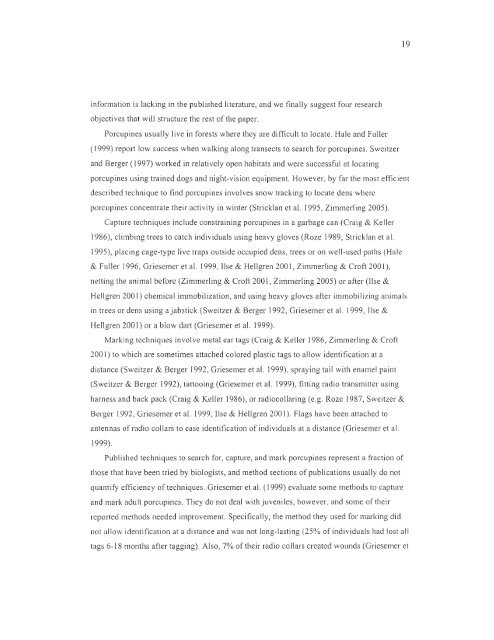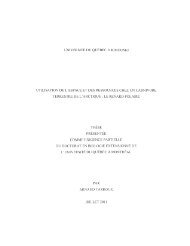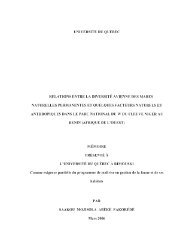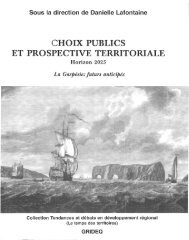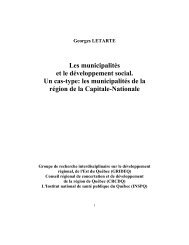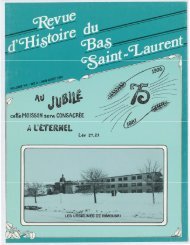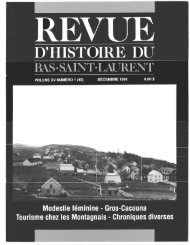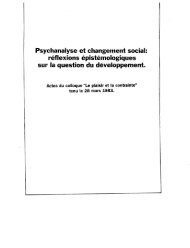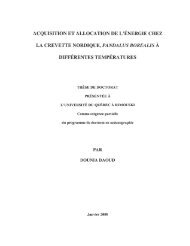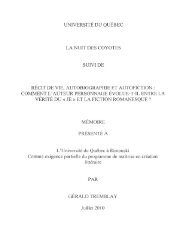influence du climat et de la prédation sur l'utilisation de l'habitat et la ...
influence du climat et de la prédation sur l'utilisation de l'habitat et la ...
influence du climat et de la prédation sur l'utilisation de l'habitat et la ...
You also want an ePaper? Increase the reach of your titles
YUMPU automatically turns print PDFs into web optimized ePapers that Google loves.
19<br />
information is <strong>la</strong>cking in the published literature, and we finally suggest four research<br />
obj ecti ves that will structure the rest of the paper.<br />
Porcupines usually live in forests where they are difficult to locate. Hale and Fuller<br />
( 1999) report low success wh en walking along transects to search for porcupines. Sweitzer<br />
and Berger (1997) worked in re<strong>la</strong>tively open habitats and were successful at locating<br />
porcupines using trained dogs and night-vision equipment. However, by far the most efficient<br />
<strong>de</strong>scribed technique to find porcupines involves snow tracking to locate <strong>de</strong>ns where<br />
porcupines concentrate their activity in winter (Strick<strong>la</strong>n <strong>et</strong> al. 1995, Zimmerling 2005).<br />
Capture techniques inclu<strong>de</strong> constraining porcupines in a garbage can (Craig & Keller<br />
1986), climbing trees to catch indivi<strong>du</strong>als using heavy gloves (Roze 1989, Strick<strong>la</strong>n <strong>et</strong> al.<br />
1995), p<strong>la</strong>cing cage-type live traps outsi<strong>de</strong> occupied <strong>de</strong>ns, trees or on well-used paths (Hale<br />
& Fuller 1996, Griesemer <strong>et</strong> al. 1999, lise & Hellgren 2001, Zimmerling & Craft 2001),<br />
n<strong>et</strong>ting the animal before (Zimmerling & Croft 2001 , Zimmerling 2005) or after (lIse &<br />
Hellgren 2001) chemical immobilization, and using heavy gloves after immobilizing animaIs<br />
in trees or <strong>de</strong>ns using a jabstick (Sweitzer & Berger 1992, Griesemer <strong>et</strong> al. 1999, lise &<br />
Hellgren 2001) or a blow dart (Griesemer <strong>et</strong> al. 1999).<br />
Marking techniques involve m<strong>et</strong>al ear tags (Craig & Keller 1986, Zimmerling & Croft<br />
2001) to which are som<strong>et</strong>imes attached colored p<strong>la</strong>stic tags to allow i<strong>de</strong>ntification at a<br />
distance (Sweitzer & Berger 1992, Griesemer <strong>et</strong> al. 1999), spraying tail with enamel paint<br />
(Sweitzer & Berger 1992), tattooing (Griesemer <strong>et</strong> al. 1999), fitting radio transmitter using<br />
hm·ness and back pack (Craig & Keller 1986), or radiocol<strong>la</strong>ring (e.g. Roze 1987, Sweitzer &<br />
Berger 1992, Griesemer <strong>et</strong> al. 1999, lIse & Hellgren 2001). F<strong>la</strong>gs have been attached to<br />
antennas of radio col<strong>la</strong>rs to ease i<strong>de</strong>ntification of indivi<strong>du</strong>als at a distance (Griesemer <strong>et</strong> al.<br />
1999).<br />
Published techniques to search for, capture, and mark porcupines represent a fraction of<br />
those that have been tried by biologists, and m<strong>et</strong>hod sections of publications usually do not<br />
quantify efficiency of techniques. Griesemer <strong>et</strong> al. (1999) evaluate some m<strong>et</strong>hods to capture<br />
and mark a<strong>du</strong>lt porcllpines. They do not <strong>de</strong>al with jllveniles, however, and some of their<br />
reported m<strong>et</strong>hods nee<strong>de</strong>d improvement. Specifically, the m<strong>et</strong>hod they used for mm"king did<br />
not allow i<strong>de</strong>ntification at a distance and was not long-<strong>la</strong>sting (25% of indivi<strong>du</strong>als had lost ail<br />
tags 6-18 months after tagging). AIso, 7% of their radio col<strong>la</strong>rs created wOllnds (Griesemer <strong>et</strong>


